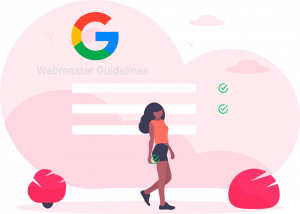Many aspire to have their business front-and-center on the first page of Google. Who wouldn’t want that?
However, few actually get there.
Often, only paid ads or posts from large websites make it to the very top of the results page. Mostly it’s the authority sites paying for the ads, which makes the climb to the top daunting for smaller sites that don’t have a big SEO budget.
It doesn’t help either that organic SEO can be painfully slow. So what gives?
All isn’t lost. I’m going to share some tips on how to get your website to rank higher on Google. Hint: It won’t involve trying to outspend the big guys.
Take a shortcut and jump straight to the findings and conclusions:
- How can contextual relevance help me rank higher on Google searches?
- Focus on relevant secondary keywords.
- Use link building tools to find contextually relevant links.
- Optimize local SEO to rank higher on Google Maps.
- Understand Search Intent.
Don’t give up on your goals, but focus on the right stuff.
The value of a front-page result is undeniable and according to Backlinko: The #1 result on Google search gets approximately 32% of all clicks.
According to Google: 53% of US consumers say that they research products using a search engine before deciding whether or not to buy.
That should convince you enough to keep doing what you’re doing!
But also consider:
The #1 spot on Google is great to have, but you don’t need to be in the top three positions to see an increase in your organic traffic.
While it’s a fact that high visibility on the SERPs can be a massive plus for your business, there are no real shortcuts to success in SEO. Increasing organic traffic and improving your position on the SERPs can take years before solid results show. It’s going to take a lot of patience and persistence on your part. Your personal mantra should be:
Commit to building a SEO strategy that is flexible and focuses on relevance and value at its core.
How can contextual relevance help me rank higher on Google searches?
What does relevance have to do with SEO? Everything!
Google’s entire mission statement is built around the ability to provide users with relevant results.
“Google’s mission is to organize the world’s information to make it universally accessible and useful.”
From this statement, it’s clear to see that providing users with useful, relevant content is at the core of Google’s strategy.
Over the years, Google has increasingly zeroed-in on relevance, incorporating AI-based text comprehension as early as 10 years ago with its Panda algorithm. It’s no secret that the search engine favors relevant, high-quality content over static authority metrics.
While authority metrics are useful and have their place in SEO, they don’t capture the whole picture.
We think relevance metrics are the missing piece of the puzzle and provide a major boost to SEO whilst being a perfect complement to other important SEO metrics, such as PageRank and domain authority.
But don’t take our word for it. Applying relevance in SEO has worked for countless others, as well.
Focus on relevant secondary keywords.
Keyword research is an indispensable part of any SEO strategy, and you’d do well to focus on both primary and secondary keywords.
While primary keywords may get more attention, secondary keywords are vital to your rankings and can help improve content quality.
Once you’ve identified the primary keywords you want to rank for, look into incorporating secondary keywords to add context to your content.
The Google algorithm is sophisticated and can see beyond keywords and phrases to understand the semantics behind them.
Therefore, it’s imperative to select secondary keywords that are semantically linked to your primary keywords. They must also be aligned with the broader URL topic of your pages.
Tabtimize Tip?: You can identify semantically linked secondary keywords by looking at the bottom of the search results page. Or, use Google autocomplete.
Use link building tools to find contextually relevant links.
Google has always been elusive about their ranking criteria but revealed some years ago that backlinks, content, and RankBrain are their Top 3 ranking factors.
Building links can be hard, but there’s no denying the value they provide to your SEO strategy.
Without relevant links, it’s virtually impossible to achieve the visibility on the SERPs you are aiming for.
However, it’s essential to remember that not all links are the same.
As Google prioritizes providing the most relevant and reliable results, they give higher weight to topically relevant sources over others.
This is noted in a Google patent from 2010 that reveals that topical relevance in SEO is weighted higher than authority metrics.
Because of the difficulty involved in building links, using link building tools to supplement your efforts can provide a major boost.
Fun Fact: The Tabtimize platform uses machine learning to analyze web-pages through 7 levels of text and context analysis, quickly understanding important information such as content topics, relevant keywords, and much more. Once the platform breaks down the data, it can assess the percentage of contextual relevance between pieces of content. This way, you only see the most relevant link opportunities for your site.
Optimize Local SEO to rank higher on Google Maps.
Local search is becoming increasingly more important as more people use their smartphones to search for businesses in their area.
The COVID-19 pandemic has further sped up this trend and optimizing for local SEO is no longer a “nice-to-have”.
If you want your business to appear in relevant searches in 2022, local SEO is a must.
Ranking high on Google Maps is a strategic way to amplify your business visibility on local searches.
They can be helped by the following.
- Google My Business: Claim your Google My Business Listing and provide an accurate business citation or NAP. (Name, Address, Phone number, domain URL, etc.) Once you have your citation up, it’s important to distribute it across relevant sources such as local listings, websites, and directories.
- Build backlinks: When building backlinks for local search and Google maps, be sure to link out to relevant or authority sources, as they will provide maximum impact. Also, don’t forget to incorporate relevant anchor text that appears naturally within your content.
Tabtimize Tip?: The Tabtimize platform only shows you relevant prospects that have a strong content-fit to yours.
- Adopt a mobile-first mindset: Mobile searches have skyrocketed in the past few years, and now surpass desktop searches. Since introducing Google’s Core Web Vitals, user experience on mobile and alternative devices can now affect rankings. Going beyond mobile-friendliness and providing an excellent user experience is key.
- Invest in UX for your homepage: Optimizing your homepage is an indispensable element of any SEO strategy, but a seamless UX experience can make or break your rankings on local search. The URL linked to your Google Maps list can attract a significant amount of traffic to your homepage, so it’s crucial to ensure that visitors have an easy and engaging experience.
Understand Search Intent.
Alongside link building, understanding search intent is one of the most important aspects of a solid SEO strategy.
Grasping user intent can have a tremendous impact on your content quality, and subsequently, your rankings.
To give you an example of search intent, we typed in the phrase “git analytics” to see what the top 10 results look like. Can you identify any patterns in the image below?
The screenshot shows that Google shows the most results for pages that deal with a Git software or analytics tool.
There is only one knowledge page (i.e. a blog result).
To help you visualize this better, we’ve labeled the intention to find a service or tool as “DO”. The intention to gain more knowledge or learn about Git analytics is labeled as “KNOW”.
Breaking down search intent is important because if users can easily find what they’re looking for on your site, Google will notice.
This is possible largely because of RankBrain, a machine learning algorithm that processes search results to retrieve the most relevant results for users.
Since its release, RankBrain has sped up the keyword ranking process. It has also enhanced Google’s ability to spot high-quality content from a human’s perspective.
RankBrain can also analyze user interaction and engagement with the search results.
If you’ve ever created a piece of content that initially performed well but saw a steady decline in traffic, you’d be wise to look into user intent that your content may be missing.
An easy way to start is to look at the top results of the front page.
What questions and concerns are they addressing? What user intent might they be capturing that your content is not?
Once you gain a better understanding of your target audience’s search intent, go back and reframe older content. Alternatively, you can also create new and improved pieces.
Bottom Line
Though the SEO world is complex, it doesn’t mean that you need to break the bank to see real results. Simplify the process by focusing on what really matters to Google, relevant search results, and build your strategy with relevance at its core. I’m curious to see out of the strategies listed in this article, which will you be trying first? Let me know your choices in the comments below.



